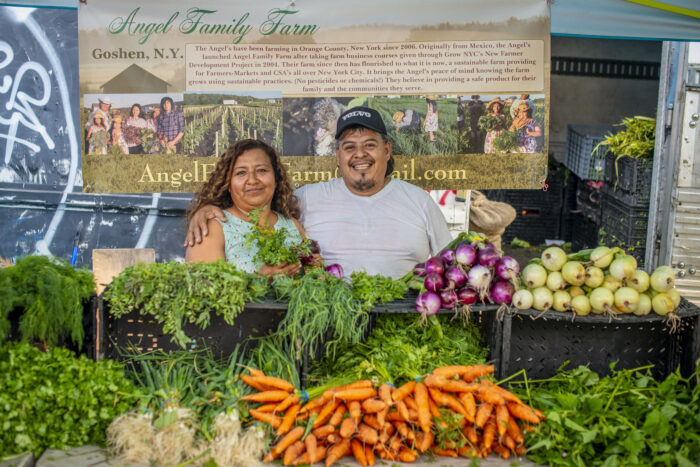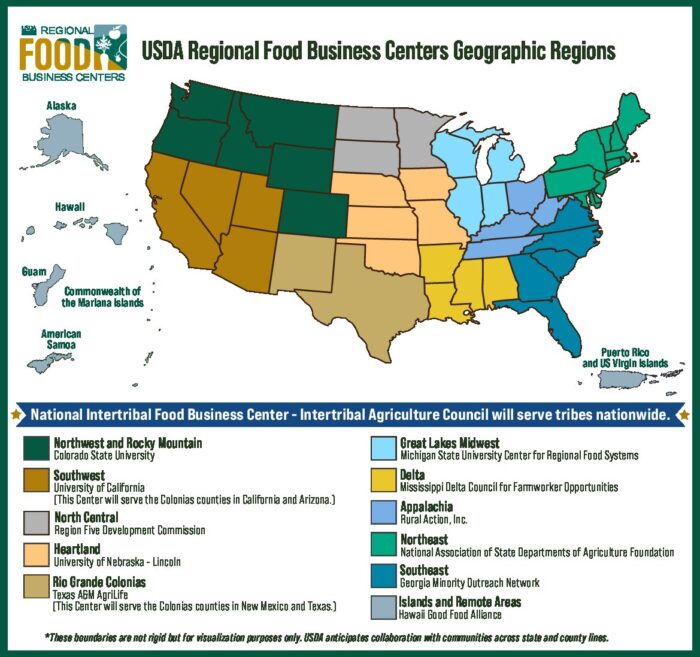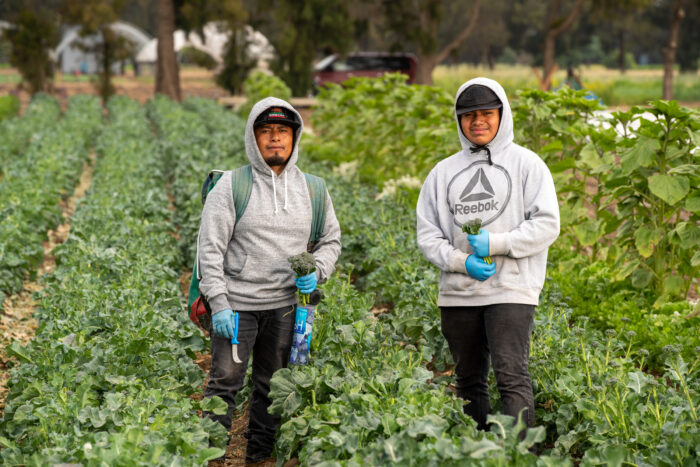
Local farmers play an essential role in keeping our communities fed and thriving. While individuals can readily buy freshly harvested items from farmers at the farmers market, options for accessing local food are expanding. Increasingly, families can find it in local grocery stores, restaurants, and schools.
The local and regional food systems that support this network of local producers, retailers, and consumers are receiving growing recognition and support for their unique value add every time we experience a global supply chain disruption (such as the war in Ukraine, the COVID-19 pandemic, and climate change). In one recent example, President Biden issued an executive order to strengthen supply chains, and with funding authorized under the American Rescue Plan Act, USDA’s Agricultural Marketing Service (AMS) began making unique investments to strengthen supply chains by building on existing partnerships and initiatives and prioritizing resources where they are needed most. Earlier this year, AMS announced the selection of the twelve new Regional Food Business Centers (Centers) that will have three primary responsibilities:
- Collaborate with a wide range of regional partners and stakeholders to develop a strategic plan for the Center’s region, coordinate existing initiatives, and develop new opportunities to support a more resilient and competitive food system.
- Provide business technical assistance across the supply chain – to producers, processors, aggregators, and distributors – with an emphasis on small- and mid-sized businesses to increase their participation in the regional food system.
- Deploy “business builder” grants to support businesses in building their capacity or expanding their business.
Regional Food Business Center Structure
In May of this year, USDA initiated cooperative agreements with twelve organizations that will lead the operation of their respective regional center, managing project activities and coordinating with a team for planning and implementation. Each Center will cover a distinct geographic area that expands across multiple states or territories, or in the case of the National Intertribal Center the entire nation. USDA AMS staff will be assigned to the Centers to ensure USDA funding opportunities and resources are actively shared out and learnings from the ground are shared back with national programmatic staff. While the Centers will not have a physical location, they will develop online platforms that can be a place for businesses to get information as well as promote connections across the supply chain.

While each Center has one distinct organizational lead, they are led by a wide range of partners that include formal entities like state agencies, institutions of higher education, nonprofit organizations, economic development corporations, and networks of stakeholders such as producer networks or associations, and local food councils.
For example, Michigan State University’s Center for Regional Food Systems, an NSAC member, will lead the Great Lakes Midwest Center alongside four key partners – Chicago Food Policy Action Council, Northwest Indiana Food Council, Food Finance Institute, and the Menominee Indian Tribe (a partnership of several Indigenous tribes). Each of these partners will play a role in coordinating activities within their service areas, Michigan, Illinois, Indiana, and Wisconsin, respectively.
Rodger Cooley, the Executive Director of the Chicago Food Policy Action Council, an NSAC member, shared “the Centers will be a great opportunity to serve small-scale and underserved producers through technical assistance and connecting them to impactful USDA programming and resources like the Local Food Purchase Program, Local Food in Schools, and eventually the new Regional Food System Infrastructure grants that will be available in Illinois soon.” Rodger went on to share about how this initiative is unique from other USDA AMS grants noting that “the five year commitment is significant. We are able to hire someone focused solely on supporting farmers through the larger ecosystem and direct business builder grants to producers. We will be able to take our experience in this work to influence state level policy in Illinois while learning from the other states in the Center.”
Unique Regional Considerations
While the Regional Food Business Centers are tasked with providing business technical assistance, capacity building awards, and coordination of broader regional efforts, they will implement these initiatives considering unique regional agricultural and organizational assets and gaps within the food supply chain.
For example, The University of California Agriculture and Natural Resources was selected as the lead organization for the Southwest Center to serve California, Nevada, Utah, and Arizona. While this Center will provide services for a wide range of food and farm businesses in the region, they will dedicate specific attention to serving the predominantly rural Colonias communities to advance business development for socially disadvantaged producers in these often underserved areas.
One way that the Center will leverage existing partnerships and organizational assets to reach this community is to partner with Agriculture and Land-Based Training Association (ALBA), an NSAC member, in the Salinas Valley. For over twenty years ALBA has operated an organic farm business incubator, helping Mexican immigrant farmworkers – and other aspiring farmers – to make the transition to independent farm ownership. The incubator farm sits on 100-acres in the Salinas Valley. The program is designed to lower the barriers to starting a farm, offering subsidized access to education, technical assistance, farmland and equipment over five years. Their history working with Latino communities makes ALBA uniquely positioned to serve the Colonias border communities, and as a model for other regions through the Center’s network. For the first time, investments from the Regional Food Business Centers will allow ALBA to support the development of other land-based training programs throughout the Center’s footprint.

National Impact
While it is too early to evaluate the success of the program in its early implementation phase, the regional structure and organizations selected showcase the great potential for this program to support community-led efforts to provide business support through trusted technical assistance providers already established in their communities. It takes significant time to build genuine relationships and conduct outreach for new initiatives, particularly in underserved communities where distrust of USDA and short-term projects may be common. To address this challenge, USDA has structured the cooperative agreements for an implementation period between four to five years. This longer project period allows for organizations to hire dedicated staff, provides a longer window of time for businesses to engage with the Center, and increases the opportunities to provide technical assistance.
The Regional Food Business Centers offer an opportunity to build on the existing assets of organizations and pair outreach and technical assistance with business builder awards. While USDA will invest $400 million across the Centers, a portion of this funding will go directly to food and farm businesses to build their capacity to participate in the regional food value chain. With support from USDA staff, each Center will develop a sustainability plan to ensure the initiative extends beyond federal funding. Undoubtedly, through partnership and business development, the Centers will catalyze economic development opportunities nationwide.
Sustaining Impact through the Farm Bill
Throughout the COVID-19 pandemic, USDA responded to market and supply chain disruptions that left families and farmers vulnerable to food insecurity and unprecedented revenue loss. Last year, USDA announced a food system transformation framework that invested in strengthening essential elements of the food system, building resiliency, promoting greater competition, and generating economic opportunity for small and medium scale producers.
While these USDA initiatives addressed unique challenges along the supply chain – from production, to processing, workforce development, distribution, and market development – these investments complemented one another to address the supply chain as a whole and build true resilience. The overarching goals are to:
- build a more resilient food supply chain while reducing carbon pollution;
- create fairer markets through competition and increasing access for small scale producers to the marketplace;
- make nutritious food affordable and readily available; and
- implement all in an equitable manner so investments reach even the most remote or underserved communities.
The farm bill offers a pathway to carry forward the goals of the Food System Transformation Network, including the Regional Food Business Centers. The 2023 Farm Bill should:
- Sustain historic investments beyond the onetime infusion of funding from the American Rescue Plan Act to ensure the networks and value-chain development continue beyond the life of the initial cooperative agreements.
- Prioritize funding for agreements in an equitable manner with investments reaching underserved producers, businesses, and communities.
- Ensure sufficient geographic coverage with an emphasis on community-led centers with a smaller geographic footprint to allow for ongoing coordination among trusted partners and networks.
- Maintain the focus on partnerships of several entities and organization types that can demonstrate their track record of working within communities and readily deploy technical assistance or funding for business development.
- Require USDA to provide a report to Congress evaluating the degree, nature, and effectiveness of the Centers’ engagement with underserved producers, and make the data on which the report is based publicly available.

